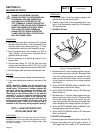
PART 2
OPERATION (8/10 KW)
STARTUP:
When the engine is started, residual magnetism from
the rotor induces a voltage into (a) the stator AC
power windings, and (b) the stator excitation or DPE
windings. The capacitor on the DPE winding will be
charged and then will discharge causing a voltage to
be induced back into the rotor.
FIELD EXCITATION:
An AC voltage is induced into the stator excitation
(DPE) windings. The DPE winding circuit is completed
to the capacitor, via Wire 2 and Wire 6.
The capacitor will charge at a rate that is dependant
on the amount of voltage that is being induced into it.
Once the capacitor is fully charged the voltage that
it discharges is a constant voltage and will in-turn
increase the size of the magnetic field of the rotor.
The greater the current flow through the rotor windings,
the more concentrated the lines of flux around the rotor
become.
The more concentrated the lines of flux around the
rotor that cut across the stationary stator windings,
the greater the voltage that is induced into the stator
windings.
AC POWER WINDING OUTPUT:
A regulated voltage is induced into the stator AC
power windings. When electrical loads are connected
across the AC power windings to complete the circuit,
current can flow in the circuit.
OPERATION (12-20 KW)
STARTUP:
When the engine is started, residual plus field boost
magnetism from the rotor induces a voltage into
(a) the stator AC power windings, and (b) the sta-
tor excitation or DPE windings. In an “on-speed”
condition, residual plus field boost magnetism are
capable of creating approximately one-half the unit’s
rated voltage.
ON-SPEED OPERATION:
As the engine accelerates, the voltage that is induced
into the stator windings increases rapidly, due to the
increasing speed at which the rotor operates.
FIELD EXCITATION:
An AC voltage is induced into the stator excitation
(DPE) windings. The DPE winding circuit is complet-
ed to the voltage regulator, via Wire 2 and Wire 6.
Unregulated alternating current can flow from the wind-
ing to the regulator.
The voltage regulator “senses” AC power winding out-
put voltage and frequency via stator Wires 11 and 22.
The regulator changes the AC from the excitation
winding to DC. In addition, based on the Wires 11
and 22 sensing signals, it regulates the flow of direct
current to the rotor.
The rectified and regulated current flow from the regu-
lator is delivered to the rotor windings, via Wire 4, and
the positive brush and slip ring. This excitation current
flows through the rotor windings and is directed to
ground through the negative (-) slip ring and brush,
and Wire 0.
The greater the current flow through the rotor windings,
the more concentrated the lines of flux around the rotor
become.
The more concentrated the lines of flux around the
rotor that cut across the stationary stator windings,
the greater the voltage that is induced into the stator
windings.
Initially, the AC power winding voltage sensed by the
regulator is low. The regulator reacts by increasing
the flow of excitation current to the rotor until volt-
age increases to a desired level. The regulator then
maintains the desired voltage. For example, if voltage
exceeds the desired level, the regulator will decrease
the flow of excitation current. Conversely, if voltage
drops below the desired level, the regulator responds
by increasing the flow of excitation current.
AC POWER WINDING OUTPUT:
A regulated voltage is induced into the stator AC
power windings. When electrical loads are connected
across the AC power windings to complete the cir-
cuit, current can flow in the circuit. The regulated
AC power winding output voltage will be in direct
proportion to the AC frequency. For example, on units
rated 120/240 volts at 60 Hz, the regulator will try to
maintain 240 volts (line-to-line) at 60 Hz. This type of
regulation system provides greatly improved motor
starting capability over other types of systems.
Page 36
AC GENERATORS
SECTION 2.2
OPERATIONAL ANALYSIS


















